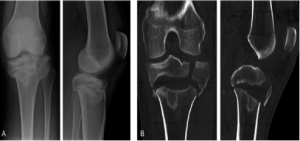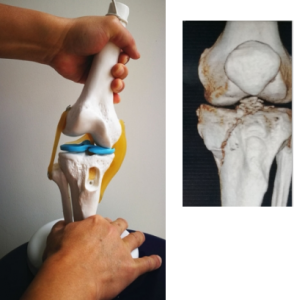Tibial plateau fractures are common periarticular fractures
Bicondylar fractures are the result of severe high-energy injury
(J Orthop Trauma 2017;30:e152–e157)
Barei DP, Nork SE, Mills WJ, et al. Complications associated with internal fixation of high-energy bicondylar tibial plateau fractures utilizing a two-incision technique. J Orthop Trauma. 2004;18:649–657.
Barei DP, O’Mara TJ, Taitsman LA, et al. Frequency and fracture morphology of the posteromedial fragment in bicondylar tibial plateau fracture patterns. J Orthop Trauma. 2008;22:176–182.
The commonly used Schatzker, Moore, and the AO/OTA classifications cover almost all fractures.
But some types of fractures are not suitable
Forms of certain fracture types suggest a potentially dangerous injury, such as a fracture-dislocation of the knee, which can have serious complications if not realized.
Bennett and Browner, Schatzker et al recognized the fracture morphology of this particular medial plateau.
(Bennett WF, Browner B. Tibial plateau fractures: a study of associated soft tissue injuries. J Orthop Trauma. 1994;8:183–188.)
Reza Firoozabadi from the United States found that hyperextension and varus tibial plateau bicondylar fractures (HEVBTP) are rarely mentioned in the literature and are not included in the commonly used fracture classification.

The authors suggest that the injury mechanism of HEVBTP is similar to that of sports medicine hyperextension and varus stress leading to anteromedial insertion fractures of the proximal tibia with damage to the posterolateral corner and/or the posterior cruciate ligament, except that the former is the posterior cortex of the proximal tibia. Tension fractures and anterior compression fractures, resulting in sagittal deformity of the lower extremity/tibia (reduced or inverted tibial posterior tilt)
Paley D, Herzenberg JE. Normal limb alignment and joint orientation. In:Principles of Deformity Correction. New York: Springer-Verlage Berlin Heidelberg; 2002:14–16.
Injury Mechanism - Hyperextension and Varus
Anterior medial tibial plateau fracture combined with posterior external complex injury
Injury mechanism: extreme hyperextension and varus of the knee
Features: Separate fracture fragments anteromedially

Fracture of the Anteromedial Tibial Plateau Associated with Posterolateral Complex Injury: Case Study and Literature Review.THE JOURNAL OF KNEE SURGERY,2011

The authors retrospectively analyzed 208 patients (212 sides) with bicondylar fractures of the tibial plateau between May 2000 and August 2011, and screened out 23 cases (25 cases) who were in line with HEVBTP characteristics after evaluation by CT scan and anterior and lateral X-ray plain films. side) tibial plateau fracture, and the remaining 187 tibial plateau fractures were used as the case and control group.
A- Lateral X-ray of the knee joint to evaluate the posterior tilt of the tibia and anterior compression fractures, and frontal X-ray showing coronal varus deformity


B-Coronal and sagittal CT images after trans-articular external fixation
C- Anterior and lateral X-ray fluoroscopy shows that the posterior fracture reduction forceps and two screws (anterior distal to posterior proximal direction) reduce and fix the proximal tibia fragment;
D- Postoperative anterior and lateral X-ray shows a medial One non-locking and one locking buttress plate fixation, where the medial plate is located on the anteromedial aspect of the tibial plateau


E-lateral X-ray plain film showed that the preoperative tibial retroversion angle was -9°, postoperatively, it was 10°, and the surgical correction angle was 19°
Post time: Apr-26-2022






